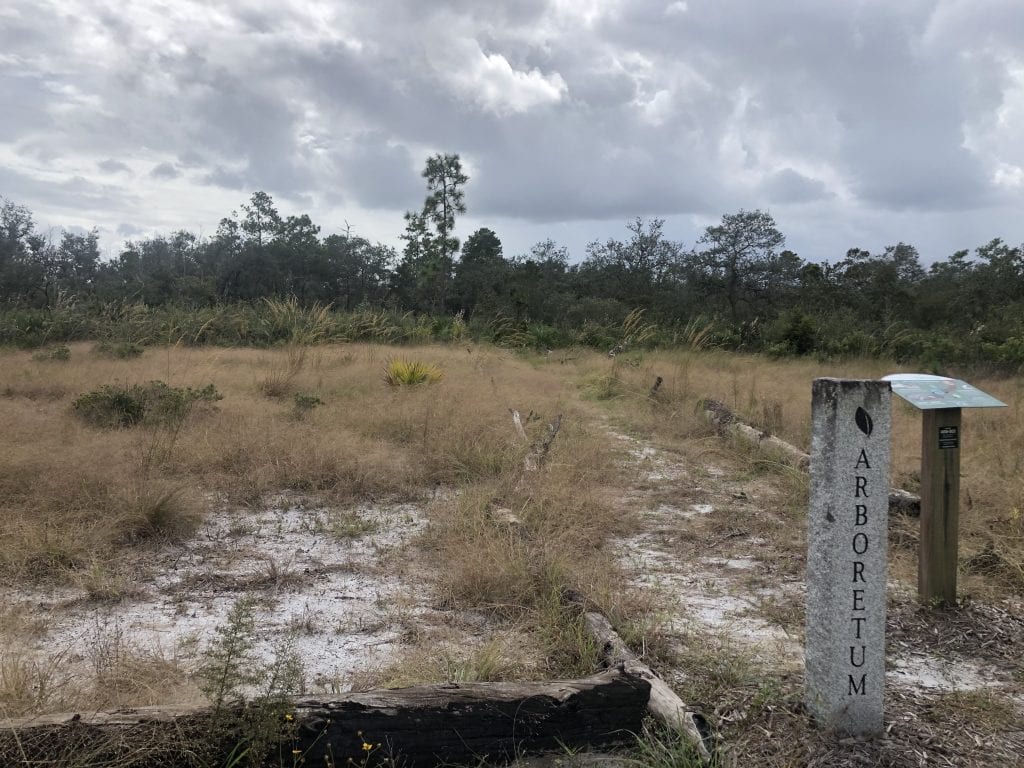Arboretum Scrub Restoration

Fall is the most wonderful time of the year for Florida’s native wildflowers! Particularly during the month of October, the Arboretum natural lands are strikingly spattered with yellows and lavenders. Our campus prescribed burn program has had huge impacts on the reduction of dense saw palmetto and oaks, opening large spaces where native wildflower and grass recruitment has been spectacular to say the least.
In addition to the impressive response we have seen in biological diversity to the reintroduction of regular fire in the longleaf pine flatwoods, we have also seen the positive results of reintroducing plants into our scrub community in 2012. Eight years after our natural resources team planted these “Scrub Circles” as part of a restoration project, these areas have become, in their own way, as unique and beautiful as the showy Sunflowers (Helianthus spp.), Tickseeds (Coreopsis spp.), Chaffheads (Carphephorus spp.), Blazing stars (Liatris spp.), and Ironweeds (Vernonia spp.) that frequent our flatwoods areas.
This restoration project was initiated to recapture two circular areas that had been cut into Florida sand pine scrub in the Arboretum natural lands as part of a tree planting project that did not include groundcover planting, and therefore became dominated by non-native bahia grass. The unique Florida scrub ecosystem, characterized in part by white sand and patches of bare sand, is critically endangered by development and has a high-level of endemism in both flora and fauna. It is home to more than two dozen threatened and endangered species including the gopher tortoise (Gopherus polyphemus) an important keystone species.
From 2012-2014 we removed the existing bahia sod and reestablished native scrub groundcover and shrubs to provide quality foraging habitat for gopher tortoises and other scrub dependent species. Reintroduced plants include Garberia (Garberia heterophylla), Britton’s Beargrass (Nolina brittoniana), Rusty Lyonia (Lyonia ferruginea), Wiregrass (Aristida stricta), Lopsided Indiangrass (Sorghastrum secundum) and Gopher Apple (Licania michauxii). In addition to these plants the scrub area adjacent to the recaptured circles supports a transplanted patch of the critically endangered Titusville balm (Dicerandra thinicola) and thriving small stands of Florida rosemary (Ceratiola ericoides).
Although Florida sand pine scrub has an infrequent fire interval of 10 – 80 years, it is a fire dependent ecosystem. Because of that, the Arboretum and natural resources teams conducted a controlled burn in the Arboretum’s small scrub area, including the scrub circles in January 2019. In the summer of 2019, months after the burn, one small Curtiss’s milkweed (Asclepias curtissii) a rare, endemic flowering milkweed was found and documented in the scrub area near the Florida rosemary. A few weeks later a large patch of it was found in one of the scrub circles, thanks to the beauty of fire!
Now that the weather is cooling off, and the holidays are almost here, we encourage you to get out into the Arboretum natural lands to explore these beautiful and biologically diverse ecosystems for yourself. Most of the flowers have passed but their beauty remains in their seed heads and their fall color.
